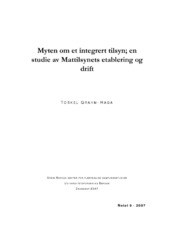| dc.contributor.author | Grahm-Haga, Torkel | eng |
| dc.date.accessioned | 2010-09-21T11:37:41Z | |
| dc.date.accessioned | 2020-12-10T06:32:05Z | |
| dc.date.available | 2010-09-21T11:37:41Z | |
| dc.date.available | 2020-12-10T06:32:05Z | |
| dc.date.issued | 2007-12 | eng |
| dc.identifier.issn | 1503-0946 | |
| dc.identifier.uri | https://hdl.handle.net/1956/4193 | |
| dc.description.abstract | This paper is based on an in-depth study of the reorganzing of the Norwegian Food Control Administration and the establishment of the Norwegian Food Safety Authority. The study concentrates on policy development at the central level during the food reform, but includes practice during the first few years of operation for the Food Safety Authority. The goal of the study is to describe and explain the course of development for Food Safety in Norway. The study is divided into three periods of time; before the Food Safety Authority, the establishment of a Norwegian Food Safety Authority, and its first years of operation.In each of these periods the variables organization, strategy, roles and regulation are studied and compared. Each variabel reflects different aspects of the regulatory agencies activities such as structure, methods and techniques for regulation, internal roles and roles towards consumers, and what the agency is meant to be regulating. The study is conducted through detailed document analysis, and in addition key actors from both former agencies and the Food Safety Authority have been interviewed. The development of the Norwegian Food Control Administration is characterized by co-ordination and standardization. Before the establishment of the Food Safety Authority the food control was viewed as fragmented with an unclear allocation of authority and responsibility. The course of development has been co-ordination in both structure and process, within a “from farm to fork” framwork. All the former agencies are joined together in the new regulatory body, and there is a new joint control strategy that covers all the levels of the food chain. This development of a uniform agency and a joint strategy reflects a change in opinion where the end product is the result of all the influence the product is exposed to during the whole process from farm to fork. Another key principle during the reorganization was a more clear cut distinction between scientific risk assessment and risk management. In this case it lead to the establishment of the Norwegian Scientific Committee for Food Safety and a shift in focus towards more administrating and controlling and less science based activity such as laboratories. Many of the changes initiated during the reorganization can be traced back to the EUs own Whitepaper on Food Safety and Food Law, but also former agencies methods and techniques are found in the new Food Safety Authority. However, many of the changes introduced by the food reform have had difficulty in settling in practice. The handling of the E.coli incident in 2006 in Norway revealed a lack of co-ordination two years after the establishment of the Food Safety Authority. Reports indicate that this food crisis enhanched the underlying problems of co-ordination that the authority struggles with during periods of normal operation. | en_US |
| dc.description.abstract | Dette notatet er basert på en detaljert studie av omorganiseringen av matforvaltningen og etablering av et samlet Mattilsyn. Fokus er på utviklingen i policy på sentralnivå under omorganiseringen, men det trekkes veksler på praksis under Mattilsynet i drift. Målet bak studien er å kunne vise hvordan matforvaltningen har utviklet seg, og skissere hva som kan forklare denne utviklingen. Studien er inndelt i tre perioder; før Mattilsynet, etablering av Mattilsynet og det nye Mattilsynet i drift. I hver av disse periodene studeres utviklingen av variablene organisering, tilsynsstrategi, roller og reguleringshensyn. Hver av disse variablene speiler ulike sider av tilsynsvirksomheten som struktur, metoder og teknikker for tilsyn, roller internt og utad mot forbrukere, samt hvilke hensyn tilsynet skal ivareta. Studien er gjennomført ved dokumentanalyse av strategiske dokument og rapporter, som er supplert med intervjuer av sentrale aktører fra tidligere tilsyn, omorganiseringsprosessen og det nye Mattilsynet. Utviklingen av matforvaltningen og matkontrollen er preget av samordning, standardisering og et behov for bedre koordinering. I forkant av etableringen av Mattilsynet var matkontrollen opplevd som fragmentert med uklar fordeling av myndighet og ansvar på matområdet. Utviklingen har gått i retning av samordningen av både struktur og prosess, og følger et fra fjord/jord til bord perspektiv. Alle tidligere etater er samlet i Mattilsynet og det er etablert en felles tilsynsstrategi for alle leddene i matkjeden. Utviklingen av et enhetlig tilsyn og en helhetlig strategi gjenspeiler seg i oppfatningen om at sluttproduktet er et resultat av de samlede påvirkninger produktet utsettes for i hele produksjonsprosessen. Et annet gjennomgående prinsipp ved overgangen til Mattilsynet er et klarere skille mellom fag, forvaltning og politikk, noe som ledet til etableringen av en uavhengig Vitenskapskomité og fokus på forvalterrollen. Flere av endringene som kom ved omorganiseringen kan spores tilbake til EUs egen matlov og matreform, men også til metoder og teknikker fra de tidligere tilsynene. Gjennomgående for flere av endringene initiert under omorganiseringen er deres mangel på å nedfelle seg i tilsynets praksis. Håndteringen av E.coli saken viste et mangelfullt enhetlig og helhetlig tilsyn to år etter samordningen, og denne krisen forsterket kraftig Mattilsynets iboende utfordringer fra sin normale driftssituasjon. | no |
| dc.language.iso | nob | eng |
| dc.publisher | Stein Rokkan Centre for Social Studies | eng |
| dc.relation.ispartofseries | Notat | en |
| dc.relation.ispartofseries | 9-2007 | en |
| dc.title | Myten om et integrert tilsyn; en studie av Mattilsynets etablering og drift | eng |
| dc.type | Working paper | eng |
| dc.rights.holder | Copyright 2007 Stein Rokkan Centre for Social Studies. All rights reserved | |
| dc.subject.nsi | VDP::Samfunnsvitenskap: 200::Statsvitenskap og organisasjonsteori: 240::Offentlig og privat administrasjon: 242 | nob |
